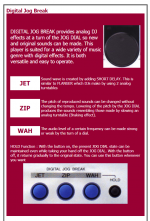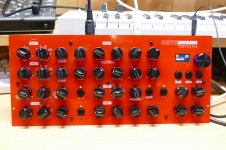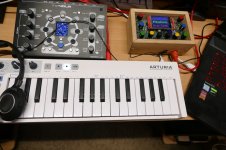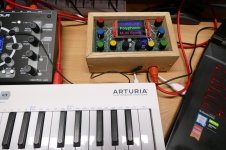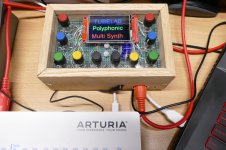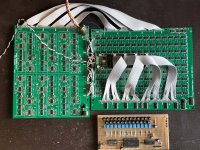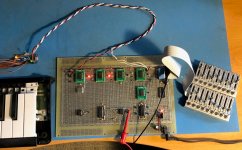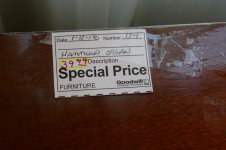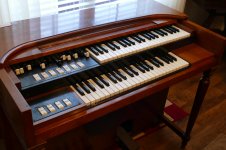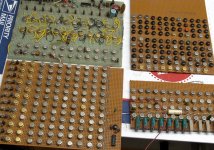Hi
Do you know about any (cheapo...) kits/schematics/projects for a standalone sound-effects for DJ'ing?
Modern DJ-consoles and CD-players often contain effects like "jet, Wah" Ect..
Please see the attached for details on the effects on the CDJ100 from Pioneer.
I suspect that a single standalone chip can do it all?
Kind regards TroelsM
Do you know about any (cheapo...) kits/schematics/projects for a standalone sound-effects for DJ'ing?
Modern DJ-consoles and CD-players often contain effects like "jet, Wah" Ect..
Please see the attached for details on the effects on the CDJ100 from Pioneer.
I suspect that a single standalone chip can do it all?
Kind regards TroelsM
Attachments
There are some using the spin semi fv-1 (i really like the dervish eurorack version). E.g. this one: FV-1 DSP Submodule — Electro-Smith
Spin asm is more difficult to learn than c though, if you want to code your own fx. But the chip makes it easy to use in a quasi-analog robust realtime fashion.
Also you could just use a beaglebone with bela Environment to run pure data. Or use the new daisy board that is arduino/teensy compatible.
Spin asm is more difficult to learn than c though, if you want to code your own fx. But the chip makes it easy to use in a quasi-analog robust realtime fashion.
Also you could just use a beaglebone with bela Environment to run pure data. Or use the new daisy board that is arduino/teensy compatible.
I use the spinsemi FV-1 for my guitar effects "reverb" and "chorus" using the factory presets. Never tried to program presets of my own as the evaluation board was a bit pricey to me. Besides this, the FV-1 delivers excellent sound effect with 16bit resolution (ca 90 dB S/N) and keeps all digital busses internal so I never had problems with noise disturbance of adjacent pre-amps.
FV-1 Spring Reverb
I know that this thread is pretty old, but I just recently rejoined the forum.
I have a lot of experience with the FV-1 chip, and was a frequent contributor on the Spin Semi support forum for several years. Also, I was the author of the algorithms used in Iron Ether effects pedals (FMeron, Divaricator, Duterra):
Iron Ether >> Pedals
Apropos to this thread, I came up with a pretty good spring reverb algorithm that I am using in some vintage suitcase guitar amps, which I just posted on the "Post your DIY Musical Instruments/Amps here!" thread. Take a look at the short clip below.
I posted the source code on the FV-1 forum so it is available to anyone for non-commercial use. I am also happy to answer any questions about the FV-1, especially for guitar effects.
I know that this thread is pretty old, but I just recently rejoined the forum.
I have a lot of experience with the FV-1 chip, and was a frequent contributor on the Spin Semi support forum for several years. Also, I was the author of the algorithms used in Iron Ether effects pedals (FMeron, Divaricator, Duterra):
Iron Ether >> Pedals
Apropos to this thread, I came up with a pretty good spring reverb algorithm that I am using in some vintage suitcase guitar amps, which I just posted on the "Post your DIY Musical Instruments/Amps here!" thread. Take a look at the short clip below.
I posted the source code on the FV-1 forum so it is available to anyone for non-commercial use. I am also happy to answer any questions about the FV-1, especially for guitar effects.
Attachments
Sorry for the double post. I don't know how that happened.
Spin Semiconductor - Welcome to Spin Semiconductor
You can see the Support Forum tab on the top line. You will also find very useful info in the Knowledge Base and Free DSP programs tabs.
The FV-1 is perfect for reverbs and other time-based effects (with the exception of loopers, due to a one-second delay memory limit). The chip is pretty long in the tooth now, but it is very easy to use compared to pretty much any other DSP: analog in and out, 3.3V power, watch crystal clock. If you don't want to mess with the bare IC, there is this:
FV-1 DSP Submodule — Electro-Smith
Programming has a significant learning curve because it is assembly language with a very unfamiliar instruction set. On the other hand, there are so many pre-written effects and example code that you can get up to speed very quickly.
Spin Semiconductor - Welcome to Spin Semiconductor
You can see the Support Forum tab on the top line. You will also find very useful info in the Knowledge Base and Free DSP programs tabs.
The FV-1 is perfect for reverbs and other time-based effects (with the exception of loopers, due to a one-second delay memory limit). The chip is pretty long in the tooth now, but it is very easy to use compared to pretty much any other DSP: analog in and out, 3.3V power, watch crystal clock. If you don't want to mess with the bare IC, there is this:
FV-1 DSP Submodule — Electro-Smith
Programming has a significant learning curve because it is assembly language with a very unfamiliar instruction set. On the other hand, there are so many pre-written effects and example code that you can get up to speed very quickly.
I am a big fan of the FV-1. From the outside world it is a pure analogue in - out device, the hole digitial section buried inside making things quite easy. Sound quality equals 16bit giving good SNR. But I never tried to customize it because the evaluation board was much to expensive to me. Hope this chip will not turn obsolete soon.
Last edited:
Actually, the audio ADCs, DACs and internal integer processing are 24-bit. Only the delay memory is a 16-bit floating point format to save silicon real estate - still plenty good enough for most applications.
Kieth Bar, the designer of the FV-1, wrote an active crossover application that cleverly extended the precision of the delay memory to full resolution for hi-fi applications. He split the memory in two, putting the 16-bit FP signal in one delay, and the difference between it and the full resolution signal in the other. Then he just added the error value to the main value at the other end of the delay. It took six instructions. Besides 24 db/oct LR crossover and tweeter delay compensation, he had program space for seven-band parametric EQ and shelving low-pass for bass boost. Pretty cool.
I am pretty sure that the chip itself will be around for a long time since it is used in so many current products. I am more worried that the development board may not be supported. Frank Thompson still runs the Spin support forum, but is now at Experimental Noize. The dev board looks to still be available there. They have been developing the apparent successor the the FV-1 called the FXCore. Unfortunately, it has been "coming soon" for years. It is certainly more capable, and has internal program flash memory, but it requires an external I2S stereo codec.
Kieth Bar, the designer of the FV-1, wrote an active crossover application that cleverly extended the precision of the delay memory to full resolution for hi-fi applications. He split the memory in two, putting the 16-bit FP signal in one delay, and the difference between it and the full resolution signal in the other. Then he just added the error value to the main value at the other end of the delay. It took six instructions. Besides 24 db/oct LR crossover and tweeter delay compensation, he had program space for seven-band parametric EQ and shelving low-pass for bass boost. Pretty cool.
I am pretty sure that the chip itself will be around for a long time since it is used in so many current products. I am more worried that the development board may not be supported. Frank Thompson still runs the Spin support forum, but is now at Experimental Noize. The dev board looks to still be available there. They have been developing the apparent successor the the FV-1 called the FXCore. Unfortunately, it has been "coming soon" for years. It is certainly more capable, and has internal program flash memory, but it requires an external I2S stereo codec.
ElectroSmith has a simple FV-1 experimenters board for $30.
FV-1 DSP Submodule — Electro-Smith
I have been tinkering with one off and on for a while mostly with synthesizer applications in mind. Their Daisy Seed is another useful device, but most of my tinkering time is still occupied with Teensy boards.
My current DIY FX experiment involves a bunch of PT2399 chips in a ring that feeds on itself. Each chip has adjustable delay, gain and feedback gain settings. Whack it with an impulse and it can be a tone generator or VCO module capable of neat Karplus - Strong plucked string sounds as well as super chaotic noise with plenty of useful sounds in between.
PT2399's can be found cheap on Amazon. It's another analog in - analog out chip with 16 bit digital in between. Intended mostly as a replacement for analog BBD chips.
This article gives some insight as to how it works and how to play with it.
ElectroSmash - PT2399 Analysis
FV-1 DSP Submodule — Electro-Smith
I have been tinkering with one off and on for a while mostly with synthesizer applications in mind. Their Daisy Seed is another useful device, but most of my tinkering time is still occupied with Teensy boards.
My current DIY FX experiment involves a bunch of PT2399 chips in a ring that feeds on itself. Each chip has adjustable delay, gain and feedback gain settings. Whack it with an impulse and it can be a tone generator or VCO module capable of neat Karplus - Strong plucked string sounds as well as super chaotic noise with plenty of useful sounds in between.
PT2399's can be found cheap on Amazon. It's another analog in - analog out chip with 16 bit digital in between. Intended mostly as a replacement for analog BBD chips.
This article gives some insight as to how it works and how to play with it.
ElectroSmash - PT2399 Analysis
No, I'm not completely sure of anything regarding the PT2399 chip. The data sheet does not say. I have seen the words Sigma Delta Modulator and 16 bit used in other texts discussing the chip.
My guess is that there is a single bit converter with enough oversampling to approximate 16 bits. The THD specs at high clock speeds tend to support this. The sampling rate varies with the clock speed (delay time) so the the THD gets worse at long delay settings.
I just chain 4 or more chips serially to get long delays. This lets you get multiple taps along the line for unique effects. I have found that sticking more than two or three together on one of those white breadboards gets too noisy. Four on a perf board proto is about the limit, so my next move would be to lay out a PCB, but that's not happening soon.
My guess is that there is a single bit converter with enough oversampling to approximate 16 bits. The THD specs at high clock speeds tend to support this. The sampling rate varies with the clock speed (delay time) so the the THD gets worse at long delay settings.
I just chain 4 or more chips serially to get long delays. This lets you get multiple taps along the line for unique effects. I have found that sticking more than two or three together on one of those white breadboards gets too noisy. Four on a perf board proto is about the limit, so my next move would be to lay out a PCB, but that's not happening soon.
Tubelab, thanks for the pointer to Electro-Smith. A while back I seriously considered making the mental and temporal investment in a CortexM7 project, but both the hardware and programming investment was just too daunting. Too much like real work for a retired EE who wants to play with music electronics! The Daisy Seed and Pod may be just the ticket to get me going again.
Your K-S project sounds very interesting. I would love to hear some clips of what you come up with. I might even try programming up a simple version on the FV-1, which should be pretty easy.
Your K-S project sounds very interesting. I would love to hear some clips of what you come up with. I might even try programming up a simple version on the FV-1, which should be pretty easy.
A while back I seriously considered making the mental and temporal investment in a CortexM7 project, but both the hardware and programming investment was just too daunting. Too much like real work for a retired EE who wants to play with music electronics!
Before diving into the Daisy Seed take a look at the Teensy series of boards from PJRC. Several yeas ago I bought a board kit for a my Eurorack synth and found out that it needed a Teensy 3.1 board. I went to the PJRC web site to get one and found a treasure trove of goodies to play with that have kept me busy ever since.
All of the 32 bit boards are ARM Cortex powered, with the 3.X series using an M4, and the 4.X series using an M7. All of them are compatible with the Arduino IDE using a plug-in available on their web site. OK, easy enough......but wait there's more.....There is a drag and drop GUI audio library that makes building everything from Guitar FX to complete polyphonic synthesizers easy enough that a retired EE can do it.....yes, I am also a retired EE (41 years at Motorola) who plays with music electronics.
Products
Teensy Audio Library, high quality sound processing in Arduino sketches on Teensy 3.1
One of my early synths, Teensy 3.6 powered, upgraded from the original 3.2:
Teensy Synth Breadboard Test - YouTube
Your K-S project sounds very interesting. I would love to hear some clips of what you come up with. I might even try programming up a simple version on the FV-1, which should be pretty easy.
I built the perf board proto with 4 PT2399 chips and a few op-amps. It had some issues that I never completely fixed, and it wound up on the shelf somewhere.....short attention span syndrome. The K-S object built into the Teensy audio library sounds far more realistic, but it is limited to frequencies above 82 Hz. It is intended to emulate a guitar and does a reasonably good job. I have a little micro synth that uses it. I really need to make some new videos with my synths.
Here are some pictures of the micro synth. It's really just a Teensy 4.1 board connected to 10 rotary encoders, a small color touch screen, a MIDI in jack, and a PT8211 stereo DAC chip that feeds a pair of LM386 chip amps. I'm still experimenting with the code, but it is now running a 6 note poly synth on one MIDI in channel, and a 6 note poly K-S synth on another. This uses about 10% of the CPU power, so there will be a few more synths added as I get the code working.
The NDLR seen in the pictures is a polyphonic MIDI pattern generator / sequencer sold by Conductive Labs. It is also Teensy based.
I recently stumbled across a Teensy powered poly synth on Youtube. I bought one of the board sets and built it. Yet another cool toy to play with.
ElectroTechnique TSynth - Teensy 4.1 based DIY Synthesizer - YouTube
I am including a picture. I haven't built a case for it yet. Still too cold and snowy for some table saw time outside.
Attachments
If you are crazy enough to make a drone synth with 1000 oscillators, or a rack full of Furbys or Game Boys, then wiring up a large collection of PT2399's shouldn't be too much of a stretch...
The Karplus Strong ish sound appears at about the 4:05 mark. Much of the rest is just noise.
BIG MUMMA DELAY PROTOTYPE JANGLY FIRST SOUNDS - Massive Delay Synth Module - YouTube
- YouTube
The Karplus Strong ish sound appears at about the 4:05 mark. Much of the rest is just noise.
BIG MUMMA DELAY PROTOTYPE JANGLY FIRST SOUNDS - Massive Delay Synth Module
Me, 30 years at Hewlett-Packard (storage, digital imaging), then another 10 years consulting.
Clearly we are kindred spirits in our "synth follies!" I have always been fascinated with Hammond organs (I have an A100 in my basement - too bad I can't play). I thought that the world needed a clonewheel that was not just software running on a fast processor, and that was "as analog as possible". The first pic below is folly #1. The left board is the tone generator. I used frequency multipliers and dividers to exactly replicate the Hammond tonewheel gear trains, then filtered them to 96 sine waves. They go to the switch matrix, consisting of 96x9 analog switches that couple each key to the nine harmonic drawbar busses. A Midi decoder generates the key presses. The proto board on the bottom accurately replicates the Hammond chorus/vibrato by electronically (rather than mechanically) scanning a 25-stage LC delay line. It uses a PIC to generate PWMs and analog switches to do the scanning of the LCs. It all sounded really good, but it was wildly impractical. (Think of all the unique Rs and Cs in 96 separate 3rd-order filters.) Besides, all-digital clonewheels have gotten too good to compete with.
Folly #2 is also Hammond inspired, but not meant to be a clone. It is officially a "hybrid paraphonic additive synth". It uses one ATtiny416 processor for each voice, in this case four-way polyphony. Each processor generates the nine harmonics of a single note. Each output is a pulse-density modulated sine wave signal that is summed with the corresponding harmonic of the other processors and RC filtered to nine analog signals. The slider pots control the summing of the drawbar signals to a single output. A fifth processor scans the keyboard and does the "note allocation" to the four voice chips. More chips can be added to make it N-way polyphonic. The plan then was to use yet another processor to generate control PWMs to VCAs to create note-on "percussion" and chorus/vibrato dynamic effects (the "paraphonic" part). Why the ATtiny chips? Because they are simple, fast, and cheap (<$0.90 apiece) - perfect for bit-banging.
That multi-oscillator drone synth stuff is way too weird for me. Is seems more "performance art noise" than instrument or music effect.
The Teensy products and tools are really interesting. I never played with Arduino - it is amazing how much hardware and software "infrastructure" has been developed. But as you can guess from the above, I am much more of a "bare metal" kind of guy. I consider complicated IDEs, libraries, middleware, peripheral drivers, nested include files, and other levels of indirection and abstraction to be a decent into "IT hell". Also, I am leery of the 16-bit analog interface for music effects. The 24-bit stereo codec on the Daisy would be at least comparable to what we have in the FV-1.
Clearly we are kindred spirits in our "synth follies!" I have always been fascinated with Hammond organs (I have an A100 in my basement - too bad I can't play). I thought that the world needed a clonewheel that was not just software running on a fast processor, and that was "as analog as possible". The first pic below is folly #1. The left board is the tone generator. I used frequency multipliers and dividers to exactly replicate the Hammond tonewheel gear trains, then filtered them to 96 sine waves. They go to the switch matrix, consisting of 96x9 analog switches that couple each key to the nine harmonic drawbar busses. A Midi decoder generates the key presses. The proto board on the bottom accurately replicates the Hammond chorus/vibrato by electronically (rather than mechanically) scanning a 25-stage LC delay line. It uses a PIC to generate PWMs and analog switches to do the scanning of the LCs. It all sounded really good, but it was wildly impractical. (Think of all the unique Rs and Cs in 96 separate 3rd-order filters.) Besides, all-digital clonewheels have gotten too good to compete with.
Folly #2 is also Hammond inspired, but not meant to be a clone. It is officially a "hybrid paraphonic additive synth". It uses one ATtiny416 processor for each voice, in this case four-way polyphony. Each processor generates the nine harmonics of a single note. Each output is a pulse-density modulated sine wave signal that is summed with the corresponding harmonic of the other processors and RC filtered to nine analog signals. The slider pots control the summing of the drawbar signals to a single output. A fifth processor scans the keyboard and does the "note allocation" to the four voice chips. More chips can be added to make it N-way polyphonic. The plan then was to use yet another processor to generate control PWMs to VCAs to create note-on "percussion" and chorus/vibrato dynamic effects (the "paraphonic" part). Why the ATtiny chips? Because they are simple, fast, and cheap (<$0.90 apiece) - perfect for bit-banging.
That multi-oscillator drone synth stuff is way too weird for me. Is seems more "performance art noise" than instrument or music effect.
The Teensy products and tools are really interesting. I never played with Arduino - it is amazing how much hardware and software "infrastructure" has been developed. But as you can guess from the above, I am much more of a "bare metal" kind of guy. I consider complicated IDEs, libraries, middleware, peripheral drivers, nested include files, and other levels of indirection and abstraction to be a decent into "IT hell". Also, I am leery of the 16-bit analog interface for music effects. The 24-bit stereo codec on the Daisy would be at least comparable to what we have in the FV-1.
Attachments
Last edited:
Clearly we are kindred spirits in our "synth follies!" I have always been fascinated with Hammond organs (I have an A100 in my basement - too bad I can't play).
I hung around some low budget recording studios as a teen in the late 60's. I got to play with whatever was in the studio when no musicians were there. Hammonds were cool, but my thing was and still is the guitar, but my 68 year old fingers don't work like they used to.
About three years ago my wife and I were wandering through a Goodwill store in Pittsburgh, and there it was. The manager said that is was non functional and being sold as furniture. He said that the power cord had been cut off to prevent use. One of the workers said otherwise. Against my wife's wishes, I brought it home. Now I need to figure out how to move the 250 pound M3 down into the basement. It is from 1958 and still works great.
Back in 1970 I went to an Emerson Lake and Palmer concert and became fascinated with the Moog synthesizer. I wanted to build one, but wound up with a PAIA 2700 kit instead.
A year or so later I decided to build a digital music synthesizer. I had dumpster dived several hundred 1970 vintage RTL logic chips (older than TTL) from the Coulter Diagnostics plant in Miami, so I had some raw material. Each round metal can TO-5 package contained a single logic gate or flip flop, so lots of chips are needed to make anything.
Following a path similar to yours, I first created the brown board on the lower right. Each chip in the bottom row makes the top octave tunable oscillators, with 3 rows of flip flops making a total of 4 octaves of kinda squareish waves. Another board with lots of RC networks made them rounder. OK, I had created a simple organ. NEXT...
The green board was a grand experiment based on the idea behind the Hammond organ, as explained in an electronics magazine sometime around 1970. The tone wheels are all spinning on a single shaft. The little bumps all "divide" the master spin rate to a lower frequency based on the number of bumps on each wheel. Why couldn't we take a single oscillator at some high frequency rate and divide it by 12 different numbers to make the individual top octave notes. This was explained in the magazine, with the math long before the Mostek 50240 chip or Mostek even existed. The green board takes a 500 KHz or so or so oscillator and divides it by an integer determined by the black and yellow wires. It worked, and feeds two more rows of flip flops for a three octave tone generator set. There are some opamps and RC filters at the top feeding the colored wires for 5 different "voices". This worked like #1 except for a global pitch bend. You could play a chord, and bend it over a nearly two octave range.
The other two boards were based on the idea that I could run everything at a higher clock speed, to make notes well above the needed range, then divide further to make the lower harmonics. This pushed the limits of the RTL logic, so I had to test chips to find those fast enough for the high frequency (2 MHz) dividers. The black epoxy Fairchild chips were faster than the metal Motorolas. There were two more boards with analog chips to filter and sum the semi-square waves. This was all being built in a gutted organ cabinet while I was working as a service tech at an Olson's Electronics store near the University of Miami. And living with my parents. My father disapproved of both my hobby and my job.
Domestic relations between myself and my father were getting bad, and came to an explosion one day. I left home with whatever I could stuff into my car and never went back. I managed to grab these boards in 1973 and still have them, the rest of the synth several other projects, lots of tubes, and anything that they couldn't sell or give away was trashed.
I had planned on rebuilding the synth, but I had found a tech job at Motorola and had more money than I could spend, so I bought a dead ARP Odyssey, and fixed it. I wish I still had that one. The boards have not seen power in nearly 50 years, so one day I'm going to fire them up if I can remember what went where.
I have made music with digital stuff off and on ever since. Major points include a SWTPC (of Tiger Amps fame) MC6800 computer system in 1975 that ran at a 921 KHz clock speed that I hacked up to 2 MHz and expanded to 128K of memory. It could bit bang out simple tunes through the parallel port chip, and read a multiplexed 3 octave keyboard through two more parallel port chips. Cakewalk 3.0, MIDI and a Korg DW8000 keyboard kept me interested off and on through the 90's and 2000's. The Pro Audio Spectrum sound cards of that time were 16 bit at 44.1 KHz. They did a decent job of recording live music in the 90's.
I started building music synthesizer stuff again about 5 years ago. This morning I finished building a sequencer module for my Eurorack modular, and I have built a few digital synths that use the TEENSY chips.
I find that 16 bits at 44.1 KHz is plenty enough if properly implemented. That's what's used in every CD made. There is an audio board available for the Teensy that runs a CS42448 chip. it is capable of 24/96 if needed. I am running it at 16/44 to cut memory requirements. It has six inputs and 8 outputs for those large synth or FX projects.
Attachments
Last edited:
OMG, you got a functional (and very nice cosmetic condition) M3 for $39 in 2021? cool synth DY development stories between you 2 by the way.
I recently started thinking about leveraging some of my parts collection towards a moog style monosynth PCB to add as an input for an ADC/DAC i'm designing, just for a bit of fun.
I recently started thinking about leveraging some of my parts collection towards a moog style monosynth PCB to add as an input for an ADC/DAC i'm designing, just for a bit of fun.
- Status
- This old topic is closed. If you want to reopen this topic, contact a moderator using the "Report Post" button.
- Home
- Live Sound
- Instruments and Amps
- Sound effects DIY?
